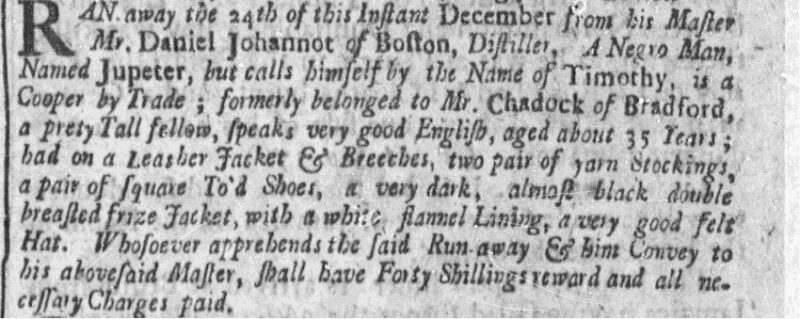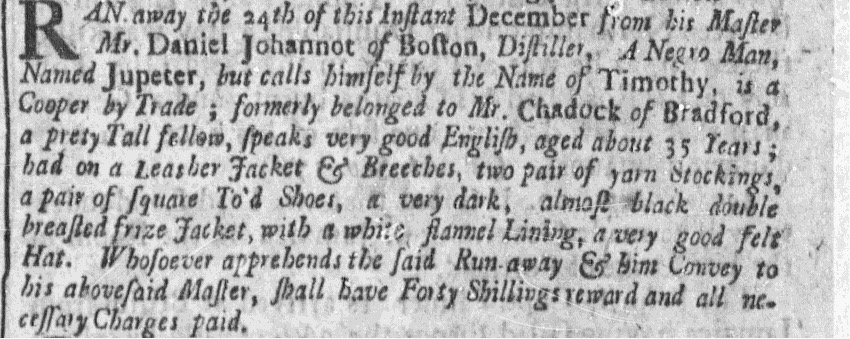The meat barrel that saved Hagar’s life* by her hiding behind it may have been made by yet another enslaved person, perhaps even Jupeter, a cooper. He had been owned by at least two different men, a Mr. Chadock of Bradford, followed by Daniel Johannot of Boston, a distiller. Distillers were in need of barrels for storing and shipping product, and were therefore in vital need of cask makers.
We know about Jupeter because he chose freedom with his feet by walking out on the distiller in late December on a cold Saturday. Johannot placed an advertisement in the local Boston News-Letter, offering a reward for his capture.
Jupeter had shown his spirit earlier, maintaining that he was to be known as Timothy, not Jupeter, as evidenced by the ad copy.
“Ran away […] A Negro Man, Named Jupeter, but calls himself by the Name Timothy, is a Cooper by Trade.”
A tall man who spoke English well, he was thirty five years old when he escaped wearing the following:
“leather Jacket & Breeches,
“two pair of yarn stockings,
“pair of square To’d Shoes,
“very good felt Hat,” and,
“very dark, almost black double breasted frize Jacket with a white flannel Lining.”
In his day and age, clothing displayed status. Everyone wore the same general types, but the fabric of construction told the story. Note that Timothy was wearing a “frize Jacket” when he left. Frize was “a woollen fabric with a long normally uncut nap” (Collins). In other words, a poor man’s material.
It was not unusual to read of other runaways wearing frize clothing when they took flight. For example, Peter was wearing “a green narrow Frize Cape” when he fled from Barnstable (117).
The fabric, osnaburg, also found its way onto Black bodies. It was a roughly textured fabric, a common cheap cloth in the North as well as the South for the enslaved (Bernstein).
The merchant John Rowe, after whom Boston’s Rowes Wharf is famously named, sold both people of color and osnaburg fabric.
“Just Imported and to be Sold, by John Rowe, at his Store, A few likely Negro Boys, and two Negro Men, between 25 and 30 Years of Age […] also […] Oznabrigs” (Boston Evening-Post).
Jupeter Negro was married by Dr. Cotton Mather [subject of another “Hosea” essay] to Elinor Negro on December 22, 1714 (Boston). We do not know if this man was one and the same, but the groom was the only one named Jupeter recorded from 1700 to 1751 in Boston’s marriage records. The ceremony took place a dozen years before he made the break.
During those years he would have been working as a cooper after a likely seven year apprenticeship. This was highly skilled work and greatly in demand because everything was shipped in barrels, from small pails to casks known as tuns that could hold over 250 gallons, and sometimes many times more.
As quickly as Timothy built his casks, tsome were filled with rum and bought by merchants who set sail for the west coast of Africa to trade for humans in bondage.
Timothy was only one of many Black enslaved men who worked the cask making trade.
Neptune Thurston, also a cooper in Boston, is remembered in association with Gilbert Stuart, the acclaimed painter. According to a reporter who met with a by then elderly Stuart, the artist was greatly influenced by Thurston. As reported in the Newport, Rhode Island “Herald of the Times”:
“Neptune was my first Master. The first idea I ever had of painting the human features, I received from seeing that old African draw a face with red ochre, chalk and charcoal on the head of a hogshead, he was to work upon […] I have often remarked, that, if that African’s mind and natural talent had been properly cultivated, he would have made a much more celebrated artist than his pupil” (Herald).
The next time you look at a dollar bill, pay close attention to the portrait of George Washington. Stuart painted him many times, but the engraved version of the portrait from 1796 lives on, and so does Neptune.
Would Gilbert have gone on to pursue the arts if not for the influence of an enslaved man in Boston drawing on the heads of barrels? We may never know the answer to that question. But we do know that Neptune played a role in a great artist’s development.
If you follow the thread from a single advertisement or article from colonial newspapers, you too will uncover the lives of unsung Black heroes, both free and bound.
*https://enslavednewengland.org/…/02/what-would-hagar-do/
Susan Elliott
Independent Researcher
WORKS CITED
Bernstein, Jason. “Osnaburg: A Sign of Wealth?” The Economy of Goods. University of Central Florida. https://projects.cah.ucf.edu/economyofgoods/ Accessed 15 Aug. 2021.
Bly, Antonio T., editor. Escaping Bondage, A Documentary History of Runaway Slaves in Eighteenth Century New England, 1700-1789. Lexington Books, 2012. [Boston Gazette, Sept. 7, 1761] https://www.google.com/…/Escaping_Bondage/eTRDqlYMcjIC…
Boston Evening-Post (Boston, Massachusetts), no. 1476, December 19, 1763: [3]. Readex: America’s Historical Newspapers. https://infoweb-newsbank-com.nehgs.idm.oclc.org/apps/readex/doc?p=EANX&docref=image/v2%3A1089C792E64CF650%40EANX-108B7195A1E43178%402365335-108B7195E7354EC8%402-108B7196966AE058%40Advertisement. ]
Boston Gazette (Boston, Massachusetts), no. 111, May 16, 1757: [2]. Readex: America’s Historical Newspapers. https://infoweb-newsbank-com.nehgs.idm.oclc.org/apps/readex/doc?p=EANX&docref=image/v2%3A1036CD2E61FB47A0%40EANX-10444FF3D5930AB9%402362927-10444FF3FA391921%401-10444FF42F28A48F%40Advertisement.
“Boston MARRIAGES, 1714 […] Jupitor Negro & Elinor Negro, Rev. Dr. Cotton Mather, Int. reads [Jupiter] [Eliner] Presbt. Dec. 22, 1714”
Boston, MA: Marriages, 1700-1809. (Online database: AmericanAncestors.org, New England Historic Genealogical Society, 2006), Originally published as: Report of the Record Commissioners of the City of Boston, Containing the Boston Marriages from 1700 to 1751 (Vol. 28), Boston, Municipal Printing office, 1898. Records Relating to the Early History of Boston, Containing Boston Marriages from 1752 to 1809 (vol. 30), Boston, Municipal Printing Office, 1903.
“Frize.” Collins dictionary. https://www.collinsdictionary.com/…/dicti…/english/frize Accessed 21 Aug. 2021.
Commonwealth Museum. “The Boston Gazette description of the Boston Massacre.” https://www.sec.state.ma.us/…/vt-boston-gazette.html
Herald of the Times. (Newport, R.I.), February 07, 1839, Image 3. https://chroniclingamerica.loc.gov/…/183…/ed-1/seq-3/…

